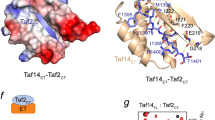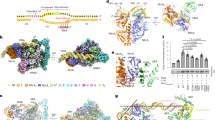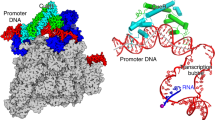Abstract
BIOCHEMICAL analyses have suggested potential targets for transcriptional activation domains, which include several components of the RNA polymerase II machinery1–7, as well as the chromatin template8–12. Here we examine the mechanism of transcriptional activation in yeast cells by connecting a heterologous DNA-binding domain (LexA) to the TATA-binding protein (TBP). LexA–TBP efficiently activates transcription from a promoter containing a LexA operator upstream of a TATA element. Activation is promoter-specific and is sensitive to mutations on the DNA-binding surface of TBP; hence it is not due to a fortuitous activation domain on TBP. Thus a promoter-bound protein lacking an activation domain can stimulate transcription if it is directly connected to TBP. This suggests that recruitment of TBP to the promoter can be a rate-limiting step for transcription in vivo, and that interactions between activation domains and factors that function after TBP recruitment can be bypassed for activation.
This is a preview of subscription content, access via your institution
Access options
Subscribe to this journal
Receive 51 print issues and online access
$199.00 per year
only $3.90 per issue
Buy this article
- Purchase on Springer Link
- Instant access to full article PDF
Prices may be subject to local taxes which are calculated during checkout
Similar content being viewed by others
References
Ingles, C. J., Shales, M., Cress, W. D., Triezenberg, S. J. & Greenblatt, J. Nature 351, 588–590 (1991).
Lin, Y.-S. & Green, M. R. Cell 64, 971–981 (1991).
Wang, W., Gralla, J. D. & Carey, M. Genes Dev. 6, 1716–1727 (1992).
Choy, B. & Green, M. R. Nature 366, 531–536 (1993).
Goodrich, J. A., Hoey, T., Thut, C. J., Admon, A. & Tjian, R. Cell 75, 519–530 (1993).
Hoey, T. et al. Cell 72, 247–260 (1993).
Lieberman, P. M. & Berk, A. J. Genes Dev. 8, 995–1006 (1994).
Workman, J. L., Roeder, R. G. & Kingston, R. E. EMB0 J. 9, 1299–1308 (1990).
Taylor, I. C. A., Workman, J. L., Schuetz, T. J. & Kingston, R. E. Genes Dev. 5, 1285–1298 (1991).
Laybourn, P. J. & Kadonaga, J. T. Science 254, 238–245 (1991).
Croston, G. E., Laybourn, P. J., Paranjape, S. M. & Kadonga, J. T. Genes Dev. 6, 2270–2281 (1992).
Imbalzano, A. N., Kwon, H., Green, M. R. & Kingston, R. E. Nature 370, 481–485 (1994).
Hope, I. A. & Struhl, K. Cell 46, 885–894 (1986).
Ma, J. & Ptashne, M. Cell 51, 113–119 (1987).
Gill, G. & Ptashne, G. Cell 51, 121–126 (1987).
Hope, I. A., Mahadevan, S. & Struhl, K. Nature 333, 635–640 (1988).
Kim, Y., Geiger, J. H., Hahn, S. & Sigler, P. B. Nature 365, 512–520 (1993).
Kim, J. L., Nikolov, D. B. & Burley, S. K. Nature 365, 520–527 (1993).
Horikoshi, M., Yamamoto, T., Ohkuma, Y., Weil, P. A. & Roeder, R. G. Cell 61, 1171–1178 (1990).
Arndt, K. M., Ricupero, S. L., Eisenmann, D. M. & Winston, F. Molec. cell Biol. 12, 2372–2382 (1992).
Strubin, M. & Struhl, K. Cell 68, 721–730 (1992).
Klein, C. & Struhl, K. Science 266, 280–282 (1994).
Tzamarias, D. & Struhl, K. Nature 369, 758–761 (1994).
Hill, D. E., Hope, I. A., Macke, J. P. & Struhl, K. Science 234, 451–457 (1986).
Harbury, P. A. B. & Struhl, K. Molec. cell. Biol. 9, 5298–5304 (1989).
Myers, A. M., Tzagoloff, A., Kinney, D. M. & Lusty, C. J. Gene 45, 299–310 (1986).
Cormack, B. P., Strubin, M., Stargell, L. A. & Struhl, K. Genes Dev. 8, 1335–1343 (1994).
Cormack, B. P., Strubin, M., Ponticelli, A. S. & Struhl, K. Cell 65, 341–348 (1991).
Brent, R. & Ptashne, M. Cell 43, 729–736 (1985).
Collart, M. & Struhl, K. Genes Dev. 8, 525–537 (1994).
Chen, J., Ding, M. & Pederson, D. S. Proc. natn. Acad. Sci. U.S.A. 91, 11909–11913 (1994).
Author information
Authors and Affiliations
Rights and permissions
About this article
Cite this article
Chatterjee, S., Struhl, K. Connecting a promoter-bound protein to TBP bypasses the need for a transcriptional activation domain. Nature 374, 820–822 (1995). https://doi.org/10.1038/374820a0
Received:
Accepted:
Issue Date:
DOI: https://doi.org/10.1038/374820a0
This article is cited by
-
Transcriptional cofactors display specificity for distinct types of core promoters
Nature (2019)
-
Transcriptional activators and activation mechanisms
Protein & Cell (2011)
-
A kinetic model of TBP auto-regulation exhibits bistability
Biology Direct (2010)
-
SAGA binds TBP via its Spt8 subunit in competition with DNA: implications for TBP recruitment
The EMBO Journal (2006)
-
Noise in eukaryotic gene expression
Nature (2003)
Comments
By submitting a comment you agree to abide by our Terms and Community Guidelines. If you find something abusive or that does not comply with our terms or guidelines please flag it as inappropriate.



